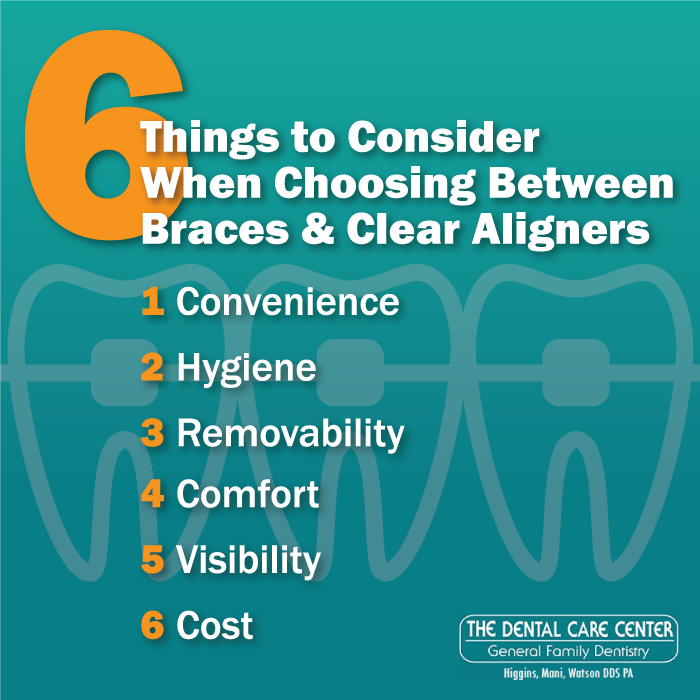
Straightening your teeth isn’t just good for your beautiful smile, it also helps reduce areas that are vulnerable to cavities and can help with chipping or grinding. When looking for a straighter smile, both braces and clear aligners can straighten your teeth. Which one is right for you is often determined by your dentist or orthodontist, based on what problem needs to be fixed and your lifestyle.
Braces consist of brackets that are fastened to your teeth with wires connecting them. They are typically tightened every few months, and can also include rubber bands to help with overbite or underbite. Clear aligners are clear trays that are created to fit your teeth and are switched out every few months to adjust to the way your teeth are moving.
One of the biggest differences is that clear aligners are removable while traditional braces are not. This means with clear aligners you have to be more disciplined, and remember to keep them in the recommended 22 hours each day. Braces, on the other hand, cannot be removed which can be inconvenient but also gives you the best chances of achieving the healthy and straight smile you’re looking for.
Many people chose clear aligners because they are less visible, and don’t take away from your smile during treatment. When using traditional braces, many people opt to get tooth-colored brackets, which are less noticeable than metal ones.
Clear aligners are overall a bit more convenient. This is because you aren’t required to go into your orthodontist every four to six weeks for an adjustment like you are with braces. Most of the time, new aligners are sent to your house every two weeks. However, that convenience can come with a bit more discomfort.
With traditional braces, you will experience discomfort when they are put on and for a few days after each adjustment, but your mouth will get used to them quickly. Many patients report discomfort with aligners each time you start a new tray, which is more often than adjustments, but it only lasts for a short amount of time. It may be tempting to take out the aligners when they are uncomfortable, but this defeats the purpose.
Dental hygiene is always important, but it’s especially important when going through orthodontic treatment. With braces, you have to be sure to brush all around the brackets and use special floss to be able to get around the wires. Clear aligners make it easier to brush and floss because you can simply remove them and brush and floss as you normally would.
Clear aligners tend to be a bit more expensive than braces, but for exact numbers you’ll have to visit your dentist/orthodontist as the cost changes based on your needs. In general, clear aligners can range from $3,500 to $8,000 while braces are on average $2,500 to $6,000. Most insurances that cover braces also cover clear aligners, but it’s best to check with your insurance company before getting started with orthodontics.
Want to learn more? Check out our website or call us today at 888-978-1779.